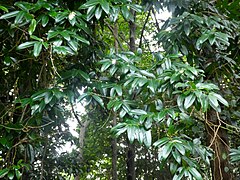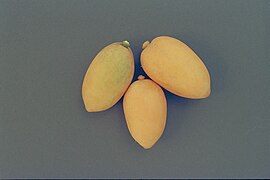Xanthophyllum fragrans
| Fragrant boxwood | |
|---|---|

| |
| Scientific classification | |
| Kingdom: | Plantae |
| Clade: | Tracheophytes |
| Clade: | Angiosperms |
| Clade: | Eudicots |
| Clade: | Rosids |
| Order: | Fabales |
| Family: | Polygalaceae |
| Genus: | Xanthophyllum |
| Species: | X. fragrans
|
| Binomial name | |
| Xanthophyllum fragrans | |
Xanthophyllum fragrans, commonly known as fragrant boxwood, is an evergreen plant in the family Polygalaceae found only in the Wet Tropics bioregion of Queensland, Australia.
Description[edit]
Xanthophyllum fragrans is a tree growing up to about 20 m (66 ft) tall, and it may produce buttress roots. The leaves are simple, arranged alternately and attached to the twigs by petioles about 10 mm (0.39 in) long; they are glossy dark green above and paler green below, and measure up to 20 cm (7.9 in) long by 7 cm (2.8 in) wide.[4][5][6]
The inflorescences are produced either terminally or in the leaf axils, and they take the form of a raceme about 12 cm (4.7 in) long. The flowers are very fragrant and quite large with five cream to yellow petals up to 7 cm (2.8 in) long and 1 cm (0.39 in) wide. The stamens are about 55 mm (2.2 in) long with anthers about 3 mm (0.12 in) long; the style is about 40 mm (1.6 in) long, the stigma is capitate (i.e. like the head of a pin).[4][5][6]
The orange fruit is (in botanical terms) a berry measuring about 9 cm (3.5 in) long and 4.5 cm (1.8 in) wide. They contain 8 or more seeds measuring about 15 mm (0.59 in) by 12 mm (0.47 in), which are completely enclosed in a cream aril.[4][5][6]
Phenology[edit]
Flowering occurs from September to October, and fruit ripen in December and January.[6]
Taxonomy[edit]
This species was first described by the Australian botanist Cyril Tenison White in his paper titled Contributions to the Queensland Flora, No. 6, which was read to the Royal Society of Queensland in November 1938. It was subsequently published in the Society's journal Proceedings of the Royal Society of Queensland in 1939.[7]
Distribution and habitat[edit]
Xanthophyllum fragrans has a restricted distribution within Queensland's Wet Tropics World Heritage Area, from near Cape Tribulation to the Kuranda National Park. It grows in well developed rainforest at altitudes from near sea level up to 1,000 m (3,300 ft).[4][5][6][8]
It has a total Area of Occupancy[a] of just 120 km2 (46 sq mi).[9]
Conservation[edit]
This species is listed by the Queensland Government's Department of Environment, Science and Innovation as near threatened.[1] As of 15 April 2024[update], it has not been assessed by the International Union for Conservation of Nature (IUCN).
Cultivation[edit]
This species is too large for the average suburban garden but it has potential as an attractive park tree due to its large fragrant flowers and colourful fruit.[5]
Gallery[edit]
-
Foliage and habit
-
Flower buds
-
Flowering
-
Mature fruit
-
Leaf x-ray
References[edit]
- ^ a b "Species profile—Xanthophyllum fragrans". Queensland Department of Environment and Science. Queensland Government. 2022. Retrieved 15 April 2024.
- ^ "Xanthophyllum fragrans". Australian Plant Name Index (APNI). Centre for Australian National Biodiversity Research, Australian Government. Retrieved 15 April 2024.
- ^ "Xanthophyllum fragrans C.T.White". Plants of the World Online. Royal Botanic Gardens, Kew. 2024. Retrieved 15 April 2024.
- ^ a b c d Telford, Ian R.H. (2022). Kodela, P.G. (ed.). "Xanthophyllum fragrans". Flora of Australia. Australian Biological Resources Study, Department of Climate Change, Energy, the Environment and Water: Canberra. Retrieved 15 April 2024.
- ^ a b c d e F.A.Zich; B.P.M.Hyland; T.Whiffen; R.A.Kerrigan (2020). "Xanthophyllum fragrans". Australian Tropical Rainforest Plants Edition 8 (RFK8). Centre for Australian National Biodiversity Research (CANBR), Australian Government. Retrieved 15 April 2024.
- ^ a b c d e Cooper, Wendy; Cooper, William T. (June 2004). Fruits of the Australian Tropical Rainforest. Clifton Hill, Victoria, Australia: Nokomis Editions. p. 560. ISBN 978-0958174213.
- ^ White, Cyril Tenison (1939). "Contributions to the Queensland Flora, No. 6". The Proceedings of the Royal Society of Queensland. 50: 67. doi:10.5962/p.351649. Retrieved 15 April 2024.
- ^ "Search: species: Xanthophyllum fragrans | Occurrence records". Australasian Virtual Herbarium. Australian Government. Retrieved 15 April 2024.
- ^ "Spatial Portal". Atlas of Living Australia. CSIRO. Retrieved 15 April 2024.
Notes[edit]
External links[edit]
- View a map of herbarium collections of this species at the Australasian Virtual Herbarium
- View observations of this species on iNaturalist
- View images of this species on Flickriver.com





